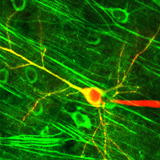This discovery has implications for the possible development of anti-cancer treatments

Certain cancerous tumors, which children suffer from, sometimes disappear by themselves. This happy phenomenon was, until now, without explanation. Now Prof. Michael Feinzylver and the members of the research group he heads, from the Department of Biological Chemistry at the Weizmann Institute of Science, believe that they have found part of the explanation for the mystery. A better understanding of this process may help, in the future, in the development of anti-cancer treatments. The research findings were published this week in the scientific journal Neuron.
Prof. Fainzilber and his group members studied a well-known protein, called TrkA, which is responsible for the vitality of nerve cells. The TrkA protein is found on the cell membrane of the nerve cells, and functions as a receptor: its binding to a certain growth factor gives the signal for a chain of intracellular events, which ultimately leads to the growth of the nerve cells and improving their ability to survive.
The scientists performed scans - with the aim of discovering additional proteins that participate in the chain of events activated by TrkA - and were surprised to discover that it is actually a "two-faced" protein. Binding of TrkA to one of the new proteins they discovered, called CCM2, causes TrkA to change its skin: instead of promoting the survival of cells, it causes their destruction.
However, the murderous activity of TrkA may actually give hope to life. This idea is based on test findings of cancerous tumors in children, which regress and disappear spontaneously. These are tumors of the neuroblastoma type - the most common solid extracranial tumor in children. Studies have shown that tumor cells that tend to regress usually contain the TrkA receptor, whereas in aggressive tumors of the same type the receptor is not found. However, the researchers could not explain how TrkA causes the tumor to disappear, and the mechanism of its activity remains a mystery.
Could CCM2 be the missing link in the chain of events leading to the spontaneous disappearance of these tumors? To answer this question, Prof. Feinzilber and the members of his research group turned to German scientists who carried out a large-scale study to test the presence of various genes in patients suffering from neuroblastoma. The CCM2 and TrkA test yielded unequivocal results: tumors that contained high levels of the TrkA gene also contained high levels of CCM2. In addition, the tumors in which both genes were found showed the highest rates of spontaneous regression, followed by the patient's recovery.
To confirm the findings, the scientists performed experiments in cell cultures, in which they prevented the creation of the CCM2 protein. As a result, the cells showed increased survivability. Next, the researchers injected CCM2 into cells that do not contain it, but do contain TrkA. The presence of both proteins together led to increased cell death. These findings strengthen the assumption that the combined activity of the two genes leads to the regression of certain cancerous tumors.
Research student Liraz Harel, post-doctoral researcher Dr. Barbara Costa, technician Zahava Levy and (then) research student Dr. Mariana Cherpkov participated in the study.

3 תגובות
From which in English the words <?
Good job.
Get up in the morning for work that may save soft souls.
Strange.. and I thought it was the nettle in the 300c dilution and the treatment at the alien clinic...